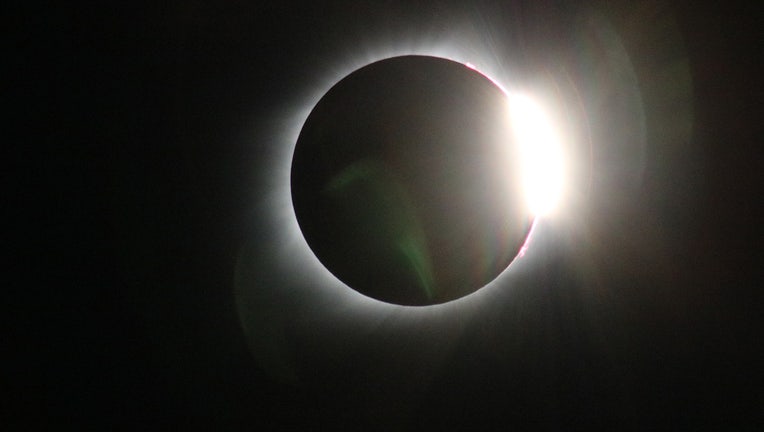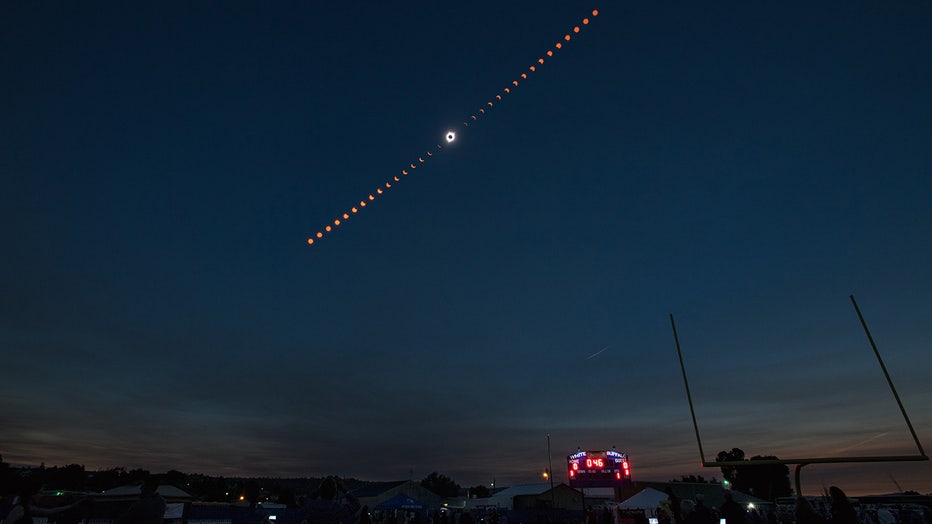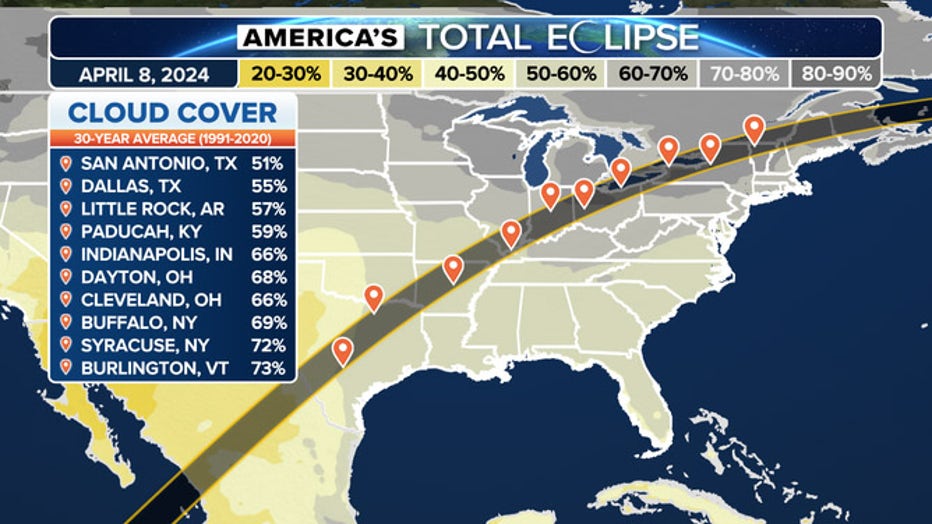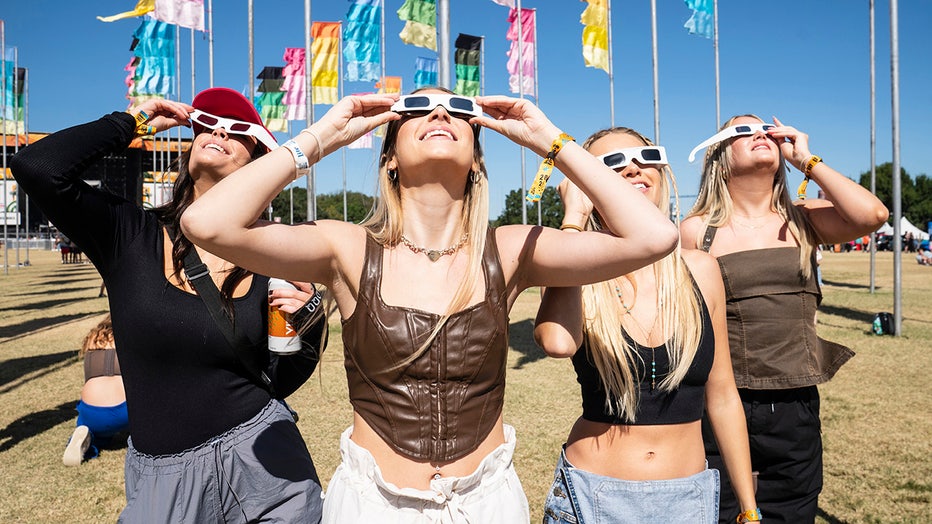The April solar eclipse is one month away: What to know now

The diamond ring signaling the end of totality is visible in this image of the Aug. 21, 2017, total solar eclipse from Madras, Oregon. (NASA/Gopalswamy)
Pretty much everyone in the United States has a chance to see the next solar eclipse, now just a month away.
On April 8, 2024, the moon will move directly between the Earth and the sun, casting a shadow across a wide swath of North America. For millions of people, daytime will briefly turn to night.
A wide variety of events are planned, from festivals to stadiums and even special flights. It’s not too late to make plans yourself; here’s what you need to know.
What is the eclipse path?
The path of totality, where the moon will completely block out the sun, will be 115 miles wide and cut diagonally across the country.
The moon’s shadow will move across Mexico, then enter the United States west of San Antonio at around 1:30 p.m. local time, crossing Austin and Dallas. From there, it cuts northeast through parts of Oklahoma, Arkansas, Missouri, Kentucky, Illinois, Indiana, and Ohio, then the northern portions of Pennsylvania, New York, Vermont, New Hampshire and Maine. Small parts of Tennessee and Michigan will also see a total solar eclipse.
RELATED: Solar eclipse 2024: These U.S. cities are in the path of totality
What will I see?

This composite image shows the progression of a total solar eclipse over Madras, Oregon on Monday, Aug. 21, 2017. (NASA/Aubrey Gemignani)
If you are in that path of totality: The moon will appear to completely block the sun for as long as seven and a half minutes. Daytime will turn into near night during that time and the sun’s corona – the outer rays – may be visible.
If you are not far from the path of totality: The moon will appear to block most of the sun. It will still become noticeably darker; daylight will become more like twilight.
If you are well outside the path of totality: You’ll notice a chunk of the sun is being blocked. The farther away you are, the smaller the moon’s bite will appear to be. In Seattle and Portland, Oregon, about as far away as you can get in the continental U.S., one-third of the sun will be swallowed.
What is the eclipse weather forecast?

Average cloud cover for the path of totality. (FOX Weather)
It’s still too early to say, but there’s some truth to the old axiom "April showers bring May flowers." April is not a particularly sunny month for much of the northern U.S., so your best chance of good weather may be in the south.
According to FOX Weather, historical data from the last 30 years suggests a 50%-60% chance of cloud cover for the portion of the path from San Antonio up through Little Rock, then a 66% or higher chance of cloud cover for Indianapolis, Cleveland, and Buffalo.
RELATED: Where you are likely to see the April total eclipse based on cloud-cover forecasts
Of note, the Cleveland Guardians’ home opener is April 8. The last two years, the team’s opener was played under mostly blue skies.
But in four out of the last 10 years, it snowed.
Where can I get eclipse glasses?

How to know if solar eclipse glasses are safe
FOX 4 consumer reporter Steve Noviello is on your side with the best way to make sure your eclipse viewing glasses are the real deal.
Even when the sun is partially blocked by the moon, it’s not safe to look directly at it. The sun’s rays can still damage your eyes. And you’ll need something more than regular sunglasses.
Eclipse glasses – with a certification stamp of "ISO 12312-2" – have extra dark film that blocks out the sun to a safe level. Many local libraries and science museums are giving them away for free right now, but the supply will run out.
Eclipse glasses can also be ordered online but experts warn that some of those products are counterfeit and may not offer the protection they claim – and you would have no way to know or test that. The American Astronomical Society has put together a list of reputable vendors and products. You can find that list on their website: eclipse.aas.org/eye-safety/viewers-filters
If you can’t get eclipse glasses, welder’s glasses can work but only if they are rated with the darkest shade level of 14.
An eclipse viewing box, which projects a shadow of the eclipse, may be a safer option for young children. Here’s how to make one.
Experts say it’s only safe to look with your bare eyes during the peak of totality, and only if you are in that path of complete totality.

How to make a solar eclipse viewing box
For those who can't get their hands on a pair of eclipse glasses, there is an alternative to the fancy specs: a DIY projection box.
Where to stay?
Hotels and short-term rentals are reporting high interest from incoming tourists. In Cleveland, over 200,000 people are expected in town for the eclipse and the NCAA Women’s Basketball Final Four, which is also that weekend. Local officials are urging travelers to be patient and expect heavy traffic – a worthwhile advisory for all eclipse tourists.
With the better weather forecast, Texas is the most booked state for the eclipse, according to Airbnb. There has been a 600% increase in searches for rentals in Texas for the eclipse. Overall, they have seen a 1,000% increase in searches.
RELATED: Texas sees 600% surge in Airbnb searches as travelers hope to see eclipse
People who are looking to book their rentals are mostly from New York, Mexico City, Seattle, Chicago and Houston.
As of last week, FOX 4 News reported that 40 percent of Airbnb’s listings along the path of totality were still available to book in Texas.
No matter where you book, experts suggest remaining flexible given the potential weather forecast, and planning a larger experience so you’ll still have fun doing other things even if clouds get in your way.

File: Festival goers watch the solar eclipse during 2023 Austin City Limits Music Festival at Zilker Park on October 14, 2023 in Austin, Texas. (Photo by Erika Goldring/FilmMagic)
When is the next eclipse?
Full solar eclipses occur every year or two or three, often in the middle of nowhere like the South Pacific or Antarctic. The next total solar eclipse, in 2026, will grace the northern fringes of Greenland, Iceland and Spain.
North America won’t experience totality again until 2033, with Alaska getting sole dibs. Then that’s it until 2044, when totality will be confined to Western Canada, Montana and North Dakota.
There won’t be another U.S. eclipse, spanning coast to coast, until 2045. That one will stretch from Northern California all the way to Cape Canaveral, Florida.
Aside from Carbondale, Illinois, in the crosshairs of both the 2017 and 2024 eclipses, it usually takes 400 years to 1,000 years before totality returns to the same spot, according to NASA.
This story was reported from Tampa, Fla. Fox Weather, KDFW, and the AP's Marcia Dunn contributed.

